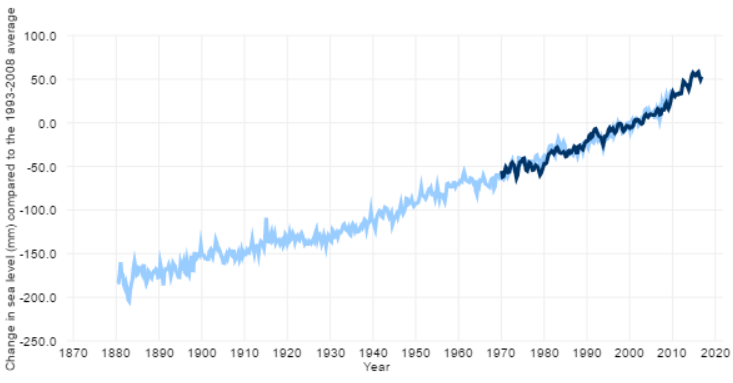- Climate
Report Heartland Institute sent to influence US teachers on climate change earns an “F” from scientists
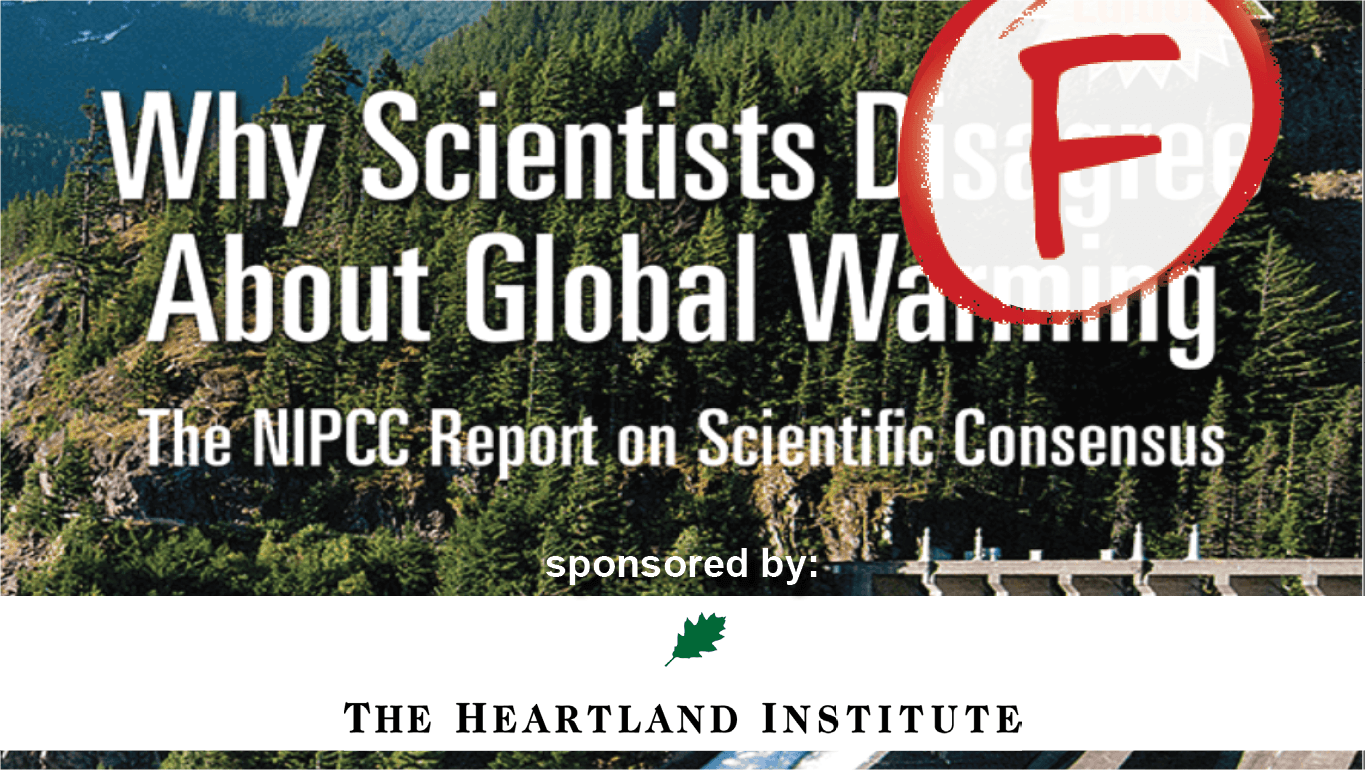
Tens of thousands of science teachers in the US have recently received an unsolicited booklet titled “Why Scientists Disagree about Global Warming”, which looks like a scientific report. It was published by the Heartland Institute (self-described as a “free-market think tank”), which plans to send a copy to every public school science teacher in the nation—more than 200,000 K-12 teachers.
So how accurate is this book meant to teach elements of the science of climate change to teachers? Climate Feedback asked scientists who actually work on these topics. Their conclusion: it could hardly score lower. Scientists found that almost all the claims that made it to the “Key Findings” section are incorrect, misleading, based on flawed logic, or simply factually inaccurate. See the list of scientists’ comments below. (An annotated copy of the report can also be found here.)
On the bright side, this book provides an opportunity for science teachers to teach their students about fallacious reasoning, as well as common misconceptions about climate science and the deceptive talking points that today floods their social media feeds under the guise of science. Teachers can also remind students that they should evaluate the source when they read a dubious claim. In this case, for instance, the promoter of this booklet is a partisan think tank, which has campaigned to downplay threats posed by secondhand smoke, acid rain, and ozone depletion, in contradiction to scientific evidence. It is not a scientific institution with a pedagogical mission.
Table of contents:
- 1. How much is the climate changing?
- 2. What causes climate change?
- 3. What are the effects of climate change?
- 4. What do scientists agree on regarding climate change?
Scientists’ Feedback
Quotes in italics are the main conclusions from the Heartland report organized by topics. Below each claim are comments from scientists actively publishing research in top-tier scientific journals.
1. How much is the climate changing?
HEARTLAND REPORT’S CLAIM: “Model outputs published in successive IPCC reports since 1990 project a doubling of CO2 could cause warming of up to 6°C by 2100. Instead, global warming ceased around the end of the twentieth century and was followed (since 1997) by 19 years of stable temperature. Earth has not warmed significantly for the past 18 years despite an 8 percent increase in atmospheric CO2.”
VERDICT:
In reality, global temperatures have continued to rise over the last few decades—notably in the oceans, which store over 90% of the excess heat trapped by the greenhouse gases humans have emitted. The claim also fails to grasp the significance of observation: because of natural variability, short-term periods of global surface temperatures cannot be assumed to always reflect the underlying long-term trend. Read full claim review

Principal Research Fellow, National Centre for Atmospheric Science
These statements are false. The IPCC has repeatedly assessed the warming due to a doubling of CO2 as between 1.5 or 2.0 °C to 4.5 °C. The warming by 2100 would be larger than this if the CO2 concentration in the atmosphere more than doubles by then.
Global warming did not cease at the end of the twentieth century—the oceans, which absorb the vast majority of the additional heat trapped by greenhouse gases, have continued to warm during this time and surface temperatures have also risen, with 2014, 2015, and 2016 being the three warmest years on record.

CNRS Research Director, Université Pierre et Marie Curie & Professor, University of Reading
The range of warming for the “business as usual” scenario of the IPCC is 4 to 6 °C. A lower CO2 emissions scenario can lead to a warming which remains below 2 °C.
There is no evidence to support the claim that global warming ceased. The observations compiled by the 3 main research groups (NOAA, NASA/GISS, UK Met Office/CRU) who provide estimates of surface global temperature all show continued warming.
Source: NASA
Natural “internal” variations occur on top of the “external” human-induced warming, leading to periods of slower warming and periods of accelerated warming. These variations are well understood by climate scientists. In the same way, Northern Hemisphere spring sees colder and warmer days (“internal” variations) superimposed onto the season’s warming due to increased “external” insolation.
Human CO2 warms not only the surface but the full depth of the ocean. The natural variations exchange heat between the surface and the deeper ocean. Periods of slower surface warming correspond to periods of faster deeper ocean warming and vice-versa. Sea level height (which also reflects deeper ocean warming) has seen no slowdown, as expected from the continued CO2 emissions. Recent work has even shown an acceleration of sea level rise*.
Source: NOAA
- Dieng et al (2017) New estimate of the current rate of sea level rise from a sea level budget approach, Geophysical Research Letters

Professor, Victoria University of Wellington
Global warming has continued uninterrupted and the last two years (2015 and 2016) are the first two to see 1°C or more of warming compared to pre-industrial temperatures. Climate models have tracked this well.

Research Scientist, Cold Regions Research and Engineering Lab
Comparing the global temperature beginning at 1997 is a common trope used by some to discredit climate science. It is an intentional cherry picking of an anomalously warm year (big El Niño) to serve as the starting point. To convince yourself, start the trend at 1998, and you’ll get a much different answer.
HEARTLAND REPORT’S CLAIM: “Doubling the concentration of atmospheric CO2 from its pre-industrial level, in the absence of other forcings and feedbacks, would likely cause a warming of ~0.3°C to 1.1°C, almost 50 percent of which must already have occurred.”
VERDICT:
This claim only highlights warming in the absence of any feedbacks, meaning it has limited relevance to the real behavior of the climate system. Without additional feedbacks, a doubling of CO2 would cause 1.2 – 1.3°C warming. Feedbacks do exist in the real world, however, and this increases the expected warming to 1.5 – 4.5°C for a doubling of atmospheric CO2 concentrations (note that “business as usual” would increase CO2 concentrations even further). Read full claim review

Postdoctoral researcher, Los Alamos National Laboratory
Neglecting feedbacks in this statement is seriously misleading to uninformed readers. Feedbacks have been clearly identified as major amplifiers of the initial CO2-forced change. These feedbacks are explicitly resolved in climate models.

Research Scientist, Lawrence Livermore National Laboratory
The first part of the statement is true, though the numerical values are off. Without other feedbacks to amplify the planetary heating due to CO2, the expected global warming from doubling CO2 is about 1.2 to 1.3°C. See p.96 of Roe (2008)1 for a nice explanation of this.
Of course, we know that there are important feedbacks in the climate system, and several of them are strong and positive, causing additional warming on top of this basic response. Narrowing down the plausible ranges of the strength of these feedbacks is an abiding goal of climate science (e.g. Stevens et al, 2016)2. Evidence has consistently pointed towards a global warming of 3°C for a doubling of CO2, albeit with uncertainty. See Armour (2017)3 for a recent study that adds to this body of evidence. So the quoted no-feedback warming of ~1 degree is completely irrelevant to Earth. It is useful only in an academic sense as a hypothetical baseline climate response that is subsequently modified by feedbacks.
The second part of the statement—that half of the warming must have already occurred (presumably because CO2 levels have increased by 50% since preindustrial)—is not true. We do not expect the ultimate global warming due to doubling of CO2 to occur at the exact moment that CO2 is doubled any more than we expect water to instantaneously boil when a pot is placed on a hot stove. There is a lag between the heating due to CO2 and the surface temperature response owing to the heat capacity of the climate system, especially the ability of the ocean to take up heat.
- 1- Roe (2008) Feedbacks, Timescales, and Seeing Red, Annual Reviews
- 2- Stevens et al (2016) Prospects for narrowing bounds on Earth’s equilibrium climate sensitivity, Earth’s Future
- 3- Armour (2017) Energy budget constraints on climate sensitivity in light of inconstant climate feedbacks, Nature Climate Change
HEARTLAND REPORT’S CLAIM: “[climate models] systematically over-estimate the sensitivity of climate to carbon dioxide … and modelers exclude forcings and feedbacks that run counter to their mission.”
VERDICT:
There is no evidence that climate models systematically overestimate the climate’s sensitivity to CO2. Rather, independent lines of research produce sensitivity estimates consistent with models. The claim also misrepresents the scientific process by assuming that science has a “mission” to reach a predetermined conclusion. Read full claim review

Professor, ETH Zürich
The statement that climate models overestimate the warming in response to CO2 is incorrect; it is based on either too short time periods that are dominated by natural variability, by the comparison of models with datasets that do not have global coverage, by comparing to models that were run many years ago with emissions and forcings that differed from what actually happened, by the use of oversimplified energy balance models1, or a combination of it. Recent studies have shown that once the changes in climate feedbacks over time2, datasets with full coverage are considered3 and all forcings are considered, the agreement between predicted and observed warming is excellent, even over the recent hiatus period4.
It is remarkable that even projections made decades ago with climate models that were much simpler (and were running on computers that were likely slower than a mobile phone today) were quite accurate5,6,7.
- 1- Knutti and Rugenstein (2015) Feedbacks, climate sensitivity and the limits of linear models, Philosophical Transactions of the Royal Society A
- 2- Armour (2017) Energy budget constraints on climate sensitivity in light of inconstant climate feedbacks, Nature Climate Change
- 3- Richardson et al (2016) Reconciled climate response estimates from climate models and the energy budget of Earth, Nature Climate Change
- 4- Medhaug et al (2017) Reconciling controversies about the ‘global warming hiatus’, Nature
- 5- Stouffer and Manabe (2017) Assessing temperature pattern projections made in 1989, Nature Climate Change
- 6- Fischer and Knutti (2016) Observed heavy precipitation increase confirms theory and early models, Nature Climate Change
- 7- Allen et al (2013) Test of a decadal climate forecast, Nature Geoscience

Professor, University of New South Wales
False. Climate Sensitivity has been assessed by the community based on recent observations and proxy data from past climates. Climate models fall within this range of sensitivity. Some recent publications point to an increase in sensitivity with warmer temperatures*.
- Paleosens Project Members (2013) Making sense of palaeoclimate sensitivity, Nature
- Meraner et al (2013) Robust increase in equilibrium climate sensitivity under global warming, Geophysical Research Letters
- Zeebe (2013) Time-dependent climate sensitivity and the legacy of anthropogenic greenhouse gas emissions, Proceedings of the National Academy of Sciences

Assistant Professor, San Jose State University
This argument reached a peak in popularity around 2012/2013 when the “hiatus” was still ongoing (i.e. when the divergence between observed and modeled global temperature was at its largest). Even then, however, it was shown that you cannot conclude much about sensitivity to CO2 from such short-term fluctuations1. Similarly, Brown et al. (2015)2 showed that decade-long periods without warming are to be expected and that there was/is a 70% chance of seeing at least one 11-year period with no warming between the years of 1993-2050 under a “middle of the road” emissions scenario.
Since then, observed warming has surged and, as of 2016, observations are warmer than the average prediction from climate models (see figures below).
- 1- Marotzke and Forster (2015) Forcing, feedback and internal variability in global temperature trends, Nature
- 2- Brown et al (2015) Comparing the model-simulated global warming signal to observations using empirical estimates of unforced noise, Scientific Reports
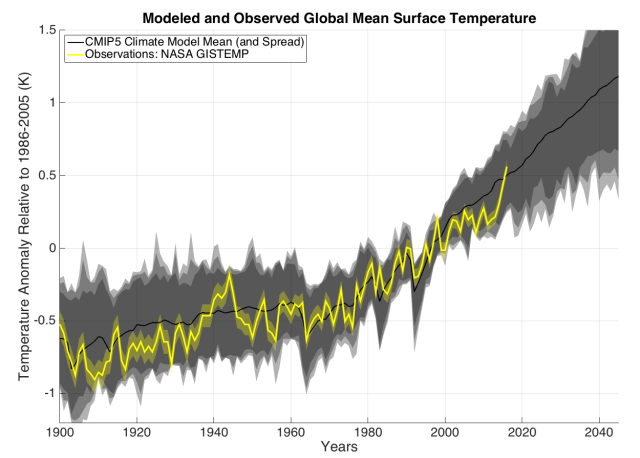
Figure – Modeled global surface temperature (RCP 4.5 emissions scenario) compared to observed temperature (NASA GISS). Source
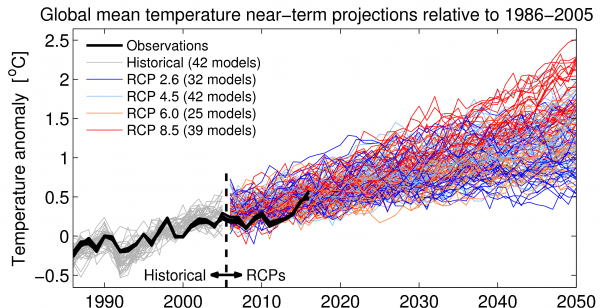
Figure – Updated version of IPCC AR5 Figure 11.25a, showing observations and the CMIP5 model projections relative to 1986-2005. The black lines represent observational datasets (HadCRUT4.5, Cowtan & Way, NASA GISTEMP, NOAA GlobalTemp, BEST). Source
2. What causes climate change?
HEARTLAND REPORT’S CLAIM: “Historically, increases in atmospheric CO2 followed increases in temperature, they did not precede them. Therefore, CO2 levels could not have forced temperatures to rise.”
VERDICT:
A lag between the initiation of past warming due to other factors and rising CO2 does not mean mean that CO2 cannot have caused temperature to increase further. Even though CO2 has been shown to begin increasing before temperature in some instances of past climate change, it also acted as a feedback that amplified warming caused by other factors like cycles in Earth’s orbit. Read full claim review

Research Scientist, SciSpace LLC, NASA Goddard Institute for Space Studies
This is both false and irrelevant.
Claims that “CO2 led temperature in the past, therefore cannot have caused it to rise” originated over a decade ago from a misrepresentation of ice core research (that itself has been subject to significant refinements in dating). It was based on the fallacy that since other factors influence climate (in this case, changes in the Earth-Sun geometry) and that the carbon cycle is affected by climate, the converse cannot be true. Of course, this is not logically coherent, and in practice is wrong since the radiative effect of CO2 is well-established. Indeed, CO2 would not be expected to fluctuate on its own 100,000 year timescale on its own, independent of the climate.
In fact, more recent research* shows that CO2 still led global temperatures and the full deglacial process, unlike in older literature that examined only Antarctic sites.
CO2 has also “led” global temperature on geologic timescales, and is largely responsible for how Earth’s temperature evolved over the last 50 million years. There are many ways to change the partitioning of carbon between the Earth and atmosphere, and how this happens is not relevant for the fact that if more CO2 is in the atmosphere, the planet will get warmer. Today, however, the excess source of carbon to the atmosphere is from humans.
- Shakun et al (2012) Global warming preceded by increasing carbon dioxide concentrations during the last deglaciation, Nature

Assistant Professor, University of Virginia
This claim is flawed. Ice core records of past greenhouse gas and atmospheric temperature change1, coupled with records of ocean temperature and circulation changes2, indicate that there are complex feedbacks between earth-atmosphere-ocean changes that lead to naturally variable greenhouse gas changes. In some cases during past deglaciations, increases in CO2 have lagged methane (CH4) increases and associated atmospheric temperature rise, owing to natural processes that induce greenhouse gas release into the atmosphere. This is not the case for twentieth century and beyond human-induced atmospheric CO2 and temperature increases.
Regardless of the source and cause of atmospheric CO2 increase, it will have a warming effect. Basic science does not change; CO2 is a greenhouse gas that is released into the atmosphere by burning of fossil fuels and leads to atmospheric warming.
- 1- Monnin et al (2001) Atmospheric CO2 Concentrations over the Last Glacial Termination, Nature
- 2- Skinner et al (2010) Ventilation of the Deep Southern Ocean and Deglacial CO2 Rise, Science
HEARTLAND REPORT’S CLAIM: “Neither the rate nor the magnitude of the reported late twentieth century surface warming (1979–2000) lay outside normal natural variability.”
VERDICT:
The short timeframe given makes it more difficult to say whether something is or is not outside the bounds of natural variability. Thorough analysis in the 2013 IPCC report concluded it was “extremely likely” (a probability of at least 95%) that humans are responsible for most of the (ongoing) change in climate experienced since 1950 (Human activity is likely responsible for all of the observed warming). Read full claim review

Assistant Professor, San Jose State University
The issue of whether or not a change in global temperature is outside the range of “normal natural variability” depends on the timescale being considered. It is true that some physical climate models (and some statistical climate models based on historically observed variability) indicate that it is possible for a warming episode as large as that seen from 1979-2000 to come about from unforced (internal) variability. However, when an unforced warming episode occurs, it is typically followed by an unforced cooling episode (if that wasn’t true, the climate would be fundamentally unstable and it would have run away to a snowball or hothouse state a long time ago). This means that the longer the sustained change in temperature, the less likely it is that the change could be due to “normal natural variability”. This is why the IPCC used a period almost 3 times longer in their attribution statement that “It is extremely likely that more than half of the observed increase in global average surface temperature from 1951 to 2010 was caused by the anthropogenic increase in greenhouse gas concentrations and other anthropogenic forcings together.”
Overall this claim is misleading because you can always pick some subset of a forced warming/cooling episode and claim that the change in temperature over that particular time frame was not outside the range of natural variability. This would be like looking at a baseball player’s season in which he hit 100 home runs and claiming that nothing unusual was going on because it is possible for a typical player to hit 3-4 home runs in a single week.

Professor, Lamont-Doherty Earth Observatory, Columbia University, and Director, Center for Climate and Life
This is a falsely constructed argument by limiting the time range to 1979 to 2000. One can cherry pick an interval and show that it’s not especially different from the past, however if one takes the full reliable record of the last 140 years the warming is unequivocal.
HEARTLAND REPORT’S CLAIM: “Solar forcings are not too small to explain twentieth century warming. In fact, their effect could be equal to or greater than the effect of CO2 in the atmosphere.”
VERDICT:
The fingerprints of the observed climatic changes do not match those that a change in solar irradiance would generate. Besides, no estimate of 20th century climate forcings (warming or cooling influences) shows the solar forcing to be close to the effect of increased CO2. Read full claim review

Professor, University of East Anglia, and Director of Research, Climatic Research Unit
There is strong evidence that solar forcing cannot explain much of the observed warming at all. The “fingerprint” of solar forcing does not match the observed changes at all, neither over time nor space. Solar forcing would warm both the stratosphere and the surface of the Earth, whereas CO2 warms the surface (and the troposphere) but cools the stratosphere. Using radiosondes and (more recently) satellites, we have observed a warming surface and troposphere together with a cooling stratosphere. See Santer et al (2013)* for one of many studies providing this evidence.
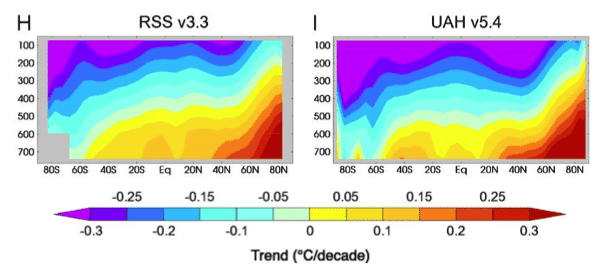 Figure – Zonal-mean atmospheric temperature trends in satellite observations from January 1979 to December 2012 showing warming of the lower atmosphere (troposphere) and cooling of the upper-atmosphere (stratosphere), from Santer et al (2013)*
Figure – Zonal-mean atmospheric temperature trends in satellite observations from January 1979 to December 2012 showing warming of the lower atmosphere (troposphere) and cooling of the upper-atmosphere (stratosphere), from Santer et al (2013)*
- Santer et al (2013) Human and natural influences on the changing thermal structure of the atmosphere, PNAS

Postdoctoral Research fellow, U.S. Geological Survey
Solar forcing is much smaller than CO2 forcing. As this figure from the latest IPCC report shows, CO2 radiative forcing (1.68 W/m2) dwarfs solar forcing (0.05 W/m2). Along with other greenhouse gases, CO2 dominates the total radiative forcing when all positive and negative factors are taken into account.
Figure – Radiative forcing estimates in 2011 relative to 1750. Values are global average radiative forcing, partitioned according to the emitted compounds or processes that result in a combination of drivers. Source IPCC AR5
HEARTLAND REPORT’S CLAIM: “Forward projections of solar cyclicity imply the next few decades may be marked by global cooling rather than warming, despite continuing CO2 emissions.”
VERDICT:
Research shows that even a substantial lull in solar activity would be far too weak to counteract human-caused global warming. Read full claim review

Senior Scientist, Potsdam Institute for Climate Impact Research (PIK)
While there are some indicators that future solar activity might indeed be lower, this will have little effect on global temperatures. See, for example, this RealClimate post based on Feulner and Rahmstorf (2010)1.
The results have been confirmed by a number of follow-up studies2-4.
While regional and seasonal effects might be larger, the expected global temperature response to a future grand solar minimum similar to the Maunder Minimum is a cooling of about 0.1°C. It should be pointed out that this cooling would occur on the background of current anthropogenic warming which is about a factor of 10 larger[…] It is also clear from these numbers that a future grand solar minimum (which would last only for a few decades anyway) would not save us from global warming, as we have shown in a scientific paper* and explained in this RealClimate post. The marginal temperature differences between warming scenarios with and without a future Maunder Minimum is illustrated here:

Figure – Rise of global temperature for two different emission scenarios (A1B, red, and A2, magenta). The dashed lines show the slightly reduced warming in case a Maunder-like solar minimum should occur during the 21st century. The blue line represents global temperature data. Source: PIK.
- 1- Feulner and Rahmstorf (2010) On the effect of a new grand minimum of solar activity on the future climate on Earth, Geophysical Research Letters
- 2- Anet et al (2013) Impact of a potential 21st century “grand solar minimum” on surface temperatures and stratospheric ozone. Geophysical Research Letters [“although the solar minimum results in a reduced global warming, it cannot compensate continuing anthropogenic impacts.“]
- 3- Meehl (2013) Could a future “Grand Solar Minimum” like the Maunder Minimum stop global warming? Geophysical Research Letters [“a future grand solar minimum could slow down but not stop global warming.“]
- 4- Jones et al (2012) What influence will future solar activity changes over the 21st century have on projected global near-surface temperature changes? Journal of Geophysical Research Atmospheres. [“the possible mitigation potential for future solar activity changes is much smaller than the known uncertainties and ranges in the future anthropogenic response.“]
3. What are the effects of climate change?
HEARTLAND REPORT’S CLAIM: “Though a future warming of 2°C would cause geographically varied ecological responses, no evidence exists that those changes would be net harmful to the global environment or to human well-being.”

Professor, University of East Anglia, and Director of Research, Climatic Research Unit
This is incorrect. There is a range of published evidence that future warming of 2°C would have a net adverse effect. In terms of ecological responses, for example, Warren et al. (2013) assess the changing climate ranges of almost 50,000 animal and plant species and find that projected climate changes would greatly reduce these climate ranges. From the abstract:
“Our global analysis of future climatic range change of common and widespread species shows that without mitigation, 57±6% of plants and 34±7% of animals are likely to lose ≥50% of their present climatic range by the 2080s.”
- Warren et al (2013) Quantifying the benefit of early climate change mitigation in avoiding biodiversity loss. Nature Climate Change

Professor, Lamont-Doherty Earth Observatory, Columbia University, and Director, Center for Climate and Life
There exists a great deal of evidence to suggest that a future warming up 2°C would cause great damage to the human built environment, agriculture, and ocean ecosystems. The last time the earth warmed 2 to 3°C was the Pliocene (5.3 to 2.6 million years ago), when sea level was 25 meters higher than today. 2°C warming also means that there will be far greater frequency of record heat which is known to damage commodity crop yields. Even if climate change is taken off the table, the increase in CO2 means that the ocean become much more acidified, affecting ocean productivity and ecosystems that provide us with 20% of our dietary protein.
HEARTLAND REPORT’S CLAIM: “No convincing relationship has been established between warming over the past 100 years and increases in extreme weather events. Meteorological science suggests just the opposite: A warmer world will see milder weather patterns.”

Climate Scientist, University of California, Los Angeles
This is not accurate. Substantial evidence suggests that certain kinds of extreme weather events (especially heat waves, droughts, and intense downpours) have already begun to occur more frequently over much of the Earth’s surface due to global warming (e.g., Diffenbaugh et al. 2017*). Further increases in extremes are likely as the Earth continues to warm, and such increases will most likely become detectable across broader geographic regions and for more event types (e.g. IPCC SREX, 2012*).
- Diffenbaugh et al. (2017) Quantifying the influence of global warming on unprecedented extreme climate events. Proceedings of the National Academy of Sciences
- IPCC (2012) Managing the Risks of Extreme Events and Disasters to Advance Climate Change Adaptation (SREX)

Senior Scientist, Woods Hole Research Center
I agree with Dr. Swain. Also see the Bulletin of the American Meterological Society report: Explaining Extreme Events from a Climate Perspective.

Research Scientist, Cold Regions Research and Engineering Lab
There is MUCH uncertainty with regards to how extreme weather events may change in response to global climate change, and there are lively debates within the climate community about this topic. However, there is substantial evidence that extreme events are likely to increase (e.g., O’Gorman and Schneider 2009*). The vague reference to “Meteorological Science” is a strong indication that this statement has no basis in fact.
- O’Gorman and Schneider (2009) The physical basis for increases in precipitation extremes in simulations of 21st-century climate change. Proceedings of the National Academy of Sciences

Associate Professor, University of Illinois
This statement is misleading and vague. What kind of “extreme weather events” are the authors referring to? As others have noted, there is substantial observational evidence of increased drought and extreme temperature in recent decades, as summarized in the recent National Climate Assessment. As average temperatures rise, extreme temperature events are becoming more common, which is observable by the outpacing of record highs versus record lows in recent decades (a topic also discussed recently on climate feedback). In other words, extreme (upper-tail) events become more likely as the climatologies (average conditions) shift to warmer temperatures.
Finally, what is “meteorological science” and how does it suggest the opposite? The authors provide no evidence to support the claim that a warmer world will experience milder weather patterns. This statement is an apparent attempt to confuse the issue with vague, oversimplified and contrarian statements with no explanation of the physical processes or observational evidence to support the claim.
HEARTLAND REPORT’S CLAIM: “Melting of Arctic sea ice and polar icecaps is not occurring at “unnatural” rates and does not constitute evidence of a human impact on the climate.”
VERDICT:
Observed Arctic sea ice loss, and mass loss from the Greenland and Antarctic ice sheets, is not explained by natural variability alone. Research indicates that human activity has made a significant contribution to the loss of glacial ice and Arctic sea ice. Read full claim review

Assistant Professor, University of Colorado, Boulder
This is a mostly false statement. The correct part is the East Antarctic ice sheet is close to mass balance1, 2 and that the recent changes in Antarctic sea ice cover are explained by natural variability3, 4.
The statement is definitely false for Arctic sea ice, which is decreasing dramatically since the 1990s as a response to human greenhouse gas emissions. In fact, there is a direct and linear relation between CO2 emitted and sea ice decline: each metric ton CO2 emitted leads to a 3 m2 loss of Arctic sea ice5 . The current loss of sea ice falls outside of natural variability and has been unprecedented in at least the last 1,450 years6.
West Antarctic mass loss has been rapidly increasing since the 1990s2. Glacial retreat in the Amundsen Sea region, the main driver of this mass loss, appears to have started already in the early 20th century7. The rate of retreat is rapid and widespread8, with no mechanism for future stabilisation9.
Current ice sheet mass loss contributes significantly (almost 40%10) to observed 21st century sea level rise. Until 2016, Arctic sea ice loss has dominated over slight Antarctic sea ice gain. In 2016 and 2017, Antarctic sea ice has been in decline as well, and reasons for this are currently under study.
- 1- Shepherd et al (2012) A Reconciled Estimate of Ice-Sheet Mass Balance, Science
- 2- Gardner et al (2017) Increased West Antarctic ice discharge and East Antarctic stability over the last seven years, The Cryosphere Discussions
- 3- Turner et al (2016) Antarctic sea ice increase consistent with intrinsic variability of the Amundsen Sea Low, Climate Dynamics
- 4- Meehl et al (2016) Antarctic sea-ice expansion between 2000 and 2014 driven by tropical Pacific decadal climate variability, Nature Geoscience
- 5- Notz and Stroeve (2016) Observed Arctic sea-ice loss directly follows anthropogenic CO2 emission, Science
- 6- Kinnard et al (2011) Reconstructed changes in Arctic sea ice over the past 1,450 years, Nature
- 7- Smith et al (2017) Sub-ice-shelf sediments record history of twentieth-century retreat of Pine Island Glacier, Nature
- 8- Rignot et al (2014) Widespread, rapid grounding line retreat of Pine Island, Thwaites, Smith, and Kohler glaciers, West Antarctica, from 1992 to 2011, Geophysical Research Letters
- 9- Joughin et al (2014) Marine ice sheet collapse potentially under way for the Thwaites Glacier Basin, West Antarctica, Science
- 10- Rietbroek et al (2016) Revisiting the contemporary sea-level budget on global and regional scales, PNAS
- Mouginot et al (2014) Sustained increase in ice discharge from the Amundsen Sea Embayment, West Antarctica, from 1973 to 2013, Geophysical Research Letters
A recent study* suggests that as much as 60 % of the observed loss in late-summer Arctic sea ice extent could have been caused by changes in atmospheric circulation patterns – i.e., natural causes. Natural factors can only explain a part of the observed losses, and multiple studies (reviewed in the latest IPCC report) have shown that it is not possible to explain the observed losses without considering non-natural factors.
- Ding et al (2017) Influence of high-latitude atmospheric circulation changes on summertime Arctic sea ice. Nature Climate Change
HEARTLAND REPORT’S CLAIM: “Best available data show sea-level rise is not accelerating. Local and regional sea levels continue to exhibit typical natural variability – in some places rising and in others falling.”
VERDICT:
The observed rate of global sea level rise has increased in comparison to preceding decades or centuries. This claim also misrepresents the significance of the observations: while local sea level change can be influenced by land surface elevation trends or ocean circulation variability, these additional local factors are not indicative of the global sea level trend, which is driven by global warming. Read full claim review

Professor, Earth Observatory of Singapore
False. Comparison of long tide gauge records and multi-centennial to millennial scale sea-level reconstructions from the same region indicates that the rate of rise during the instrumental period (since ~1850 CE) was significantly faster than it was during the late Holocene (the 4000–2000 years prior to ~1850 CE). The data demonstrate that an acceleration in the rate of sea-level rise occurred.
- Kopp et al (2016) Temperature-driven global sea-level variability in the Common Era, Proceedings of the National Academy of Sciences
[the article concludes: “A significant global sea level acceleration began in the 19th century and yielded a 20th century rise that is extremely likely (probability P ≥ 0.95) faster than during any of the previous 27 centuries.”]

Climate Scientist, University of California, Los Angeles
This statement is false. A wide range of direct measurements (i.e. tidal gauges) and indirect measurements (i.e., gravity monitoring satellites) show that the rate of sea level rise has increased (i.e., accelerated) in recent years*.
- Dieng et al (2017) New estimate of the current rate of sea level rise from a sea level budget approach, Geophysical Research Letters
[the article concludes: “An important increase of the global mean sea-level rate is found during the second half of the altimetry era (2004–2015) compared to the 1993–2004 time span, mostly due to Greenland mass loss increase and also to slight increase of all other components of the budget.”]

Professor, Lamont-Doherty Earth Observatory, Columbia University, and Director, Center for Climate and Life
This is untrue. The best available data show that the rate of sea level rise has more than doubled in just the last decade*.
- Hay et al (2015) Probabilistic reanalysis of twentieth-century sea-level rise, Nature

Postdoctoral researcher, Los Alamos National Laboratory
Use of “accelerating” is misleading. Even if the rate wasn’t accelerating (which it is), the fact of a steady rise would still be important.
Global average sea level is unambiguously rising. Regions where sea level is falling are regions where local sea level signals are large enough to counteract the global trend—for example, in Baffin Bay and parts of Scandinavia, where continued residual land uplift is continuing, associated with the unweighting of the land from loss of last glacial maximum ice sheets.
[more details on why local sea level changes can differ from global change can be found in the IPCC report, chapter 13][A recent study finds that sea-level rise recently accelerated significantly, the rate between 1993 and 2012 being three times faster than the rate before 1990*.]
- Dangendorf et al (2017) Reassessment of 20th century global mean sea level rise. Proceedings of the National Academy of Sciences
4. What do scientists agree on regarding climate change?
HEARTLAND REPORT’S CLAIM: “Extensive survey data show deep disagreement among scientists on scientific issues that must be resolved before the man-made global warming hypothesis can be validated.”

Climate Scientist, University of California, Los Angeles
This is not accurate. The importance of carbon dioxide in mediating the Earth’s surface temperature via the greenhouse effect has in fact been known for well over a century (e.g., Arrhenius 1896*), and an enormous volume of scientific research over decades has demonstrated that the primary cause of observed global warming is the emission of greenhouse gases by human activities (e.g., most recently, Ribes et al. 2016*).
- Arrhenius (1896) On the Influence of Carbonic Acid in the Air upon the Temperature of the Ground. Philosophical Magazine and Journal of Science
- Ribes et al. (2016) A new statistical approach to climate change detection and attribution. Climate Dynamics

Professor, Earth Observatory of Singapore
False. For example, the largest survey ever of the world’s foremost sea-level rise experts shows that a meter of warming is probable by 2100 with unchecked emissions. Horton et al., 2014*
- Horton et al. (2014) Expert assessment of sea-level rise by AD 2100 and AD 2300. Quaternary Science Reviews
HEARTLAND REPORT’S CLAIM: “IPCC, created to find and disseminate research finding a human impact on global climate, is not a credible source. It is agenda-driven, a political rather than scientific body, and some allege it is corrupt.”

Assistant Professor, University of Virginia
This statement is false. The IPCC reports are written by a large number of international scientists to comprehensively summarize existing literature on climate change in the past, present, and future and its impacts on society.

Professor, Victoria University of Wellington
A complete mis-characterisation. IPCC reports survey the existing literature. Saying the IPCC is not credible is saying the whole body of peer-reviewed literature on climate change is not credible either.



